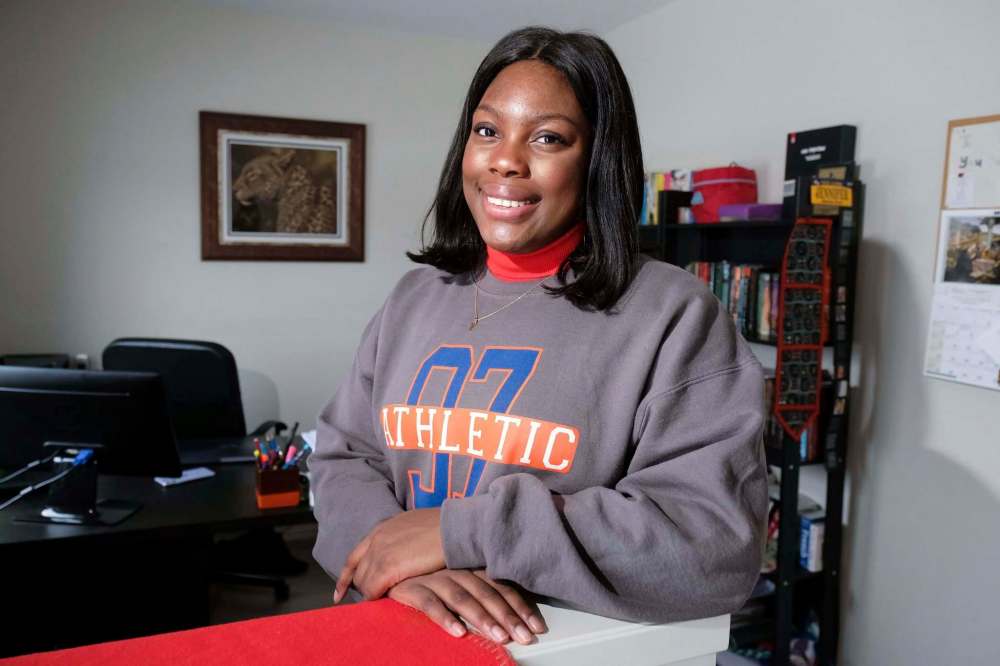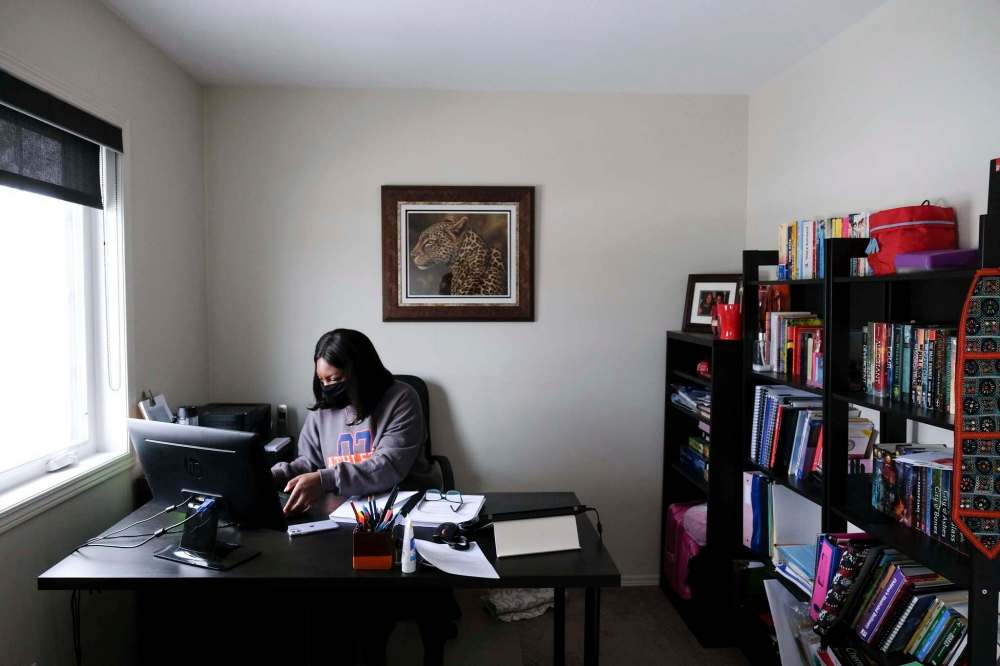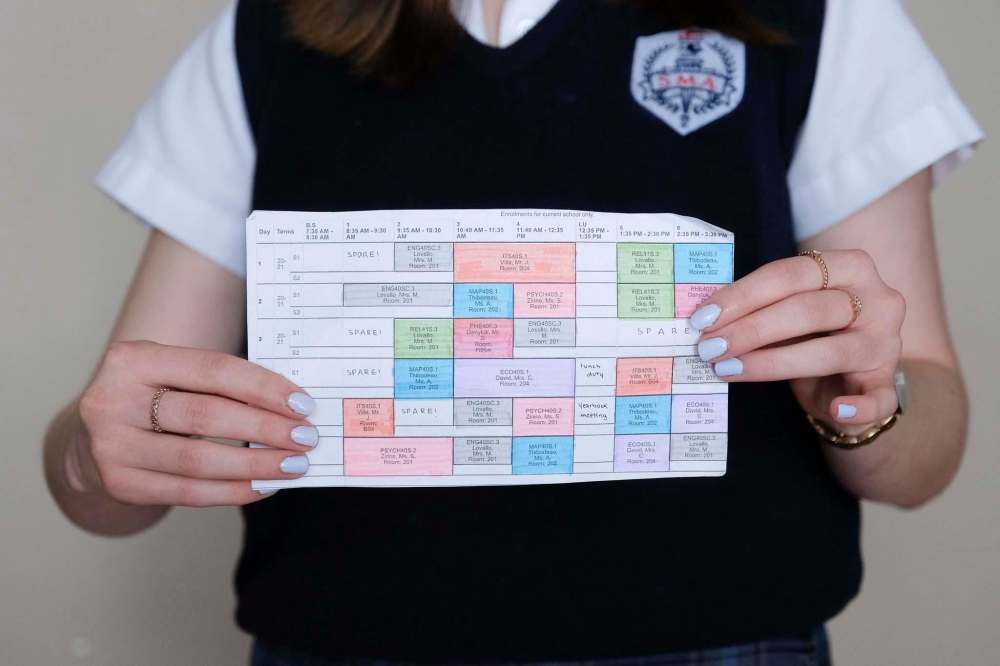Two high schools, two COVID strategies St. Mary's Academy senior in class all 49 days of fall term; Grade 12 student across street at Kelvin present 22 days, the rest online
Read this article for free:
or
Already have an account? Log in here »
To continue reading, please subscribe:
Monthly Digital Subscription
$0 for the first 4 weeks*
- Enjoy unlimited reading on winnipegfreepress.com
- Read the E-Edition, our digital replica newspaper
- Access News Break, our award-winning app
- Play interactive puzzles
*No charge for 4 weeks then price increases to the regular rate of $19.00 plus GST every four weeks. Offer available to new and qualified returning subscribers only. Cancel any time.
Monthly Digital Subscription
$4.75/week*
- Enjoy unlimited reading on winnipegfreepress.com
- Read the E-Edition, our digital replica newspaper
- Access News Break, our award-winning app
- Play interactive puzzles
*Billed as $19 plus GST every four weeks. Cancel any time.
To continue reading, please subscribe:
Add Free Press access to your Brandon Sun subscription for only an additional
$1 for the first 4 weeks*
*Your next subscription payment will increase by $1.00 and you will be charged $16.99 plus GST for four weeks. After four weeks, your payment will increase to $23.99 plus GST every four weeks.
Read unlimited articles for free today:
or
Already have an account? Log in here »
Hey there, time traveller!
This article was published 28/12/2020 (1808 days ago), so information in it may no longer be current.
High schoolers who attend a private academy in River Heights spent more than double the in-class time during the fall than their peers at a public school across the street.
When high schools unveiled every-second- and third-day schedules for Grade 9-12 students in the summer, independent schools touted timetables that would see students at school as much as possible.
An early promise of daily attendance — in line with Manitoba Education’s messaging that a physical classroom is the best environment for student learning — became a selling point for paying tuition amid the COVID-19 pandemic.
Calling St. Mary’s Academy admission numbers “strong,” president Connie Yunyk said there is unprecedented enrolment interest for the upcoming school year.
“We know that our students want to be here and we know our parents want their daughters to be here, so we’ve tried everything that we can to accommodate that.” – St. Mary’s President president Connie Yunyk
“We know that our students want to be here and we know our parents want their daughters to be here, so we’ve tried everything that we can to accommodate that,” said Yunyk, who heads the all-girls Catholic school, which has a Grade 9-12 population of 400.
Teenagers studied daily at the Wellington Crescent school until the second wave of the virus spiked in late October, prompting administration to pivot to a blended program, with alternating in-class and remote days throughout the week.
St. Mary’s administration weighed the decision before the province mandated blended learning for high schoolers.
The move initially frustrated some families who insisted they put their daughters in private school — at a cost of $7,640 per student in 2020-21, with discounts for families with multiple daughters — to ensure frequent in-person attendance.

Grade 12 students Lily Francis and Voke Ewhrudjakpor share in the same senior-year stresses that members of graduating classes before them have experienced during a final lap of Manitoba’s K-12 education system.
Good grades, extracurriculars, and getting into their first post-secondary program choices are top of mind. (Francis wants to study business at the University of Manitoba, while Ewhrudjakpor has her sights set on health sciences at Cornell University in New York State or the University of Toronto.)
What’s new this year is they are attempting to navigate senior year with physical distancing, mask-wearing and blended learning.
So far in the 2020-21 school year, Francis, 16, has been in class at St. Mary’s for all 49 days.
Ewhrudjakpor, who is in the International Baccalaureate program across Stafford Street at Kelvin High School, which has a student population of 1,300, participated in 22 in-person school days during that same period. The 17-year-old missed a single fall day to stay home after learning about a COVID-19 exposure in her cohort.

Taking into account holidays and non-instructional days on the St. Mary’s and Kelvin 2020-21 calendars, there were 65 and 68 learning days, respectively, in the fall term prior to the winter break.
“I’m not going to lie, it’s been pretty stressful,” Ewhrudjakpor said, listing off the “draining” contrast between in-class and remote days and the lack of deadline wiggle room in the IB program.
In response to a Free Press request about the difference between in-class days, a Winnipeg School Division spokesperson said the comparison is “unfair” and directed a reporter to Manitoba Education.
The province has projected a total of 196 school days in the current academic year.
Depending on the six-day school cycle rotation, Ewhrudjakpor visited Kelvin once or twice a week throughout autumn. What she has found is blended biology and math come easier than discussion-based courses such as history and English because she can teach herself concepts instead of having to rely on in-person lessons that are rushed because of time constraints.

Challenges aside, Ewhrudjakpor said her teachers are doing their best, evidenced by prompt emails and virtual-help sessions.
Francis echoed those sentiments. While there are many distractions at home, she said her teachers have put in place policies to keep students engaged and are available via video call or chat.
“I don’t think my learning’s really suffered at all,” she said, acknowledging that because competitive sports are on hiatus, extracurriculars have taken a hit, although the yearbook committee is working via Zoom.
“I have so much time on my hands. I’m like, ‘what should I fill my time with now?’ It’s been sort of more relaxing, having more time. I can focus more on school and keeping my grades up,” she said.
Remote-learning teacher Tara McLauchlan does not hesitate when asked if she thinks remote and in-class learning can be equal.

“Yes, 100 per cent,” she said. “The bad rep remote learning often gets is because of everybody’s really traumatic experience with what the spring was.”
McLauchlan, who teaches English language arts virtually to medically advised students in St. James Assiniboia, said when done well — with an emphasis on community-building and student voice and choice — students can thrive and might even prefer to continue doing online learning, post-pandemic.
While that might be the case in some pockets of the city, the executive director of the Community Education Development Association said he’s worried students in the inner city will disengage from school this year because in-class attendance isn’t required daily.
“In-person contact is what students need and want, and the schools see that, too. It’s relationship-based,” said Tom Simms of CEDA.
Given internet and device access challenges, as well as the value of schools as safe spaces for students, Simms said what’s now become known as the COVID-19 learning loss phenomenon will hit some communities harder than others.
“In-person contact is what students need and want, and the schools see that, too. It’s relationship-based.” – Tom Simms of CEDA
But if students are independent learners and teachers have effective remote strategies, in-class day differences are unlikely to yield different outcomes, said George Georgiou, an education professor at the University of Alberta studying literacy learning loss during the pandemic.
“There is no linear relationship between the days you attend face-to-face and how good of a reader you are,” he said.
Georgiou said he’s more concerned about learning loss among Grade 1-3 students, especially those who were struggling readers pre-pandemic, since his early research shows younger learners’ skills have suffered in comparison to other groups.
The president of St. Mary’s said public and private schools alike are doing their best right now, but she doesn’t believe there will be a place for blended learning when the pandemic is over, at least not on her campus.
A screen is no substitute for socialization or the “sacred bonds” between pupils and teachers, she said.
“We’ve been in the business of educating young women for 151 years, and for 151 years we’ve been doing this on site, on campus.”
maggie.macintosh@freepress.mb.ca
Twitter: @macintoshmaggie

Maggie Macintosh reports on education for the Winnipeg Free Press. Funding for the Free Press education reporter comes from the Government of Canada through the Local Journalism Initiative.
Our newsroom depends on a growing audience of readers to power our journalism. If you are not a paid reader, please consider becoming a subscriber.
Our newsroom depends on its audience of readers to power our journalism. Thank you for your support.
History
Updated on Tuesday, December 29, 2020 9:23 AM CST: punctuation added





